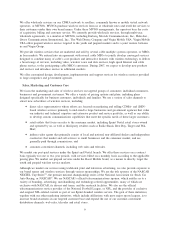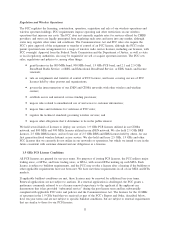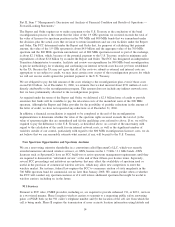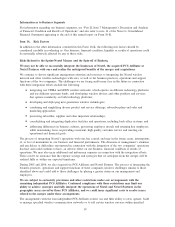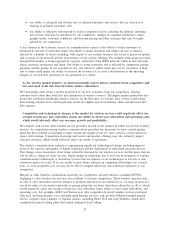Sprint - Nextel 2006 Annual Report Download - page 16
Download and view the complete annual report
Please find page 16 of the 2006 Sprint - Nextel annual report below. You can navigate through the pages in the report by either clicking on the pages listed below, or by using the keyword search tool below to find specific information within the annual report.Part II, Item 7 “Management’s Discussion and Analysis of Financial Condition and Results of Operations —
Forward-Looking Statements.”
The Report and Order requires us to make a payment to the U.S. Treasury at the conclusion of the band
reconfiguration process to the extent that the value of the 1.9 GHz spectrum we received exceeds the total of
the value of licenses for spectrum positions in the 700 MHz and 800 MHz bands that we surrendered under
the decision, plus the actual costs that we incur to retune incumbents and our own facilities under the Report
and Order. The FCC determined under the Report and Order that, for purposes of calculating that payment
amount, the value of the 1.9 GHz spectrum is about $4.9 billion and the aggregate value of the 700 MHz
spectrum and the 800 MHz spectrum surrendered, net of 800 MHz spectrum received as part of the exchange,
is about $2.1 billion, which, because of the potential payment to the U.S. Treasury, results in minimum cash
expenditures of about $2.8 billion by us under the Report and Order. The FCC has designated an independent
Transition Administrator to monitor, facilitate and review our expenditures for 800 MHz band reconfiguration.
A precise methodology for evaluating and confirming our internal network costs has not yet been established
by the TA. Because the TA may not agree that all of the costs we submit as external and internal costs are
appropriate or are subject to credit, we may incur certain costs as part of the reconfiguration process for which
we will not receive credit against the potential payment to the U.S. Treasury.
We are obligated to pay the full amount of the costs relating to the reconfiguration plan, even if those costs
exceed $2.8 billion. As of December 31, 2006, we estimate that we had incurred about $721 million of costs
directly attributable to the reconfiguration program. This amount does not include any indirect network costs
that we have preliminarily allocated to the reconfiguration program.
As required under the terms of the Report and Order, we delivered a $2.5 billion letter of credit to provide
assurance that funds will be available to pay the relocation costs of the incumbent users of the 800 MHz
spectrum. Although the Report and Order provides for the possibility of periodic reductions in the amount of
the letter of credit, we have not requested any reductions as of December 31, 2006.
In addition, a financial reconciliation is required to be completed at the end of the reconfiguration
implementation to determine whether the value of the spectrum rights received exceeds the total of (i) the
value of spectrum rights that are surrendered and (ii) the qualifying costs referred to above. If so, we will be
required to pay the difference to the U.S. Treasury, as described above. As a result of the uncertainty with
regard to the calculation of the credit for our internal network costs, as well as the significant number of
variables outside of our control, particularly with regard to the 800 MHz reconfiguration licensee costs, we do
not believe that we can reasonably estimate what amount, if any, will be paid to the U.S. Treasury.
New Spectrum Opportunities and Spectrum Auctions
We are a non-voting, minority shareholder in a consortium called SpectrumCo LLC, which was recently
awarded numerous advanced wireless services, or AWS, licenses in the 1.7 GHz / 2.1 GHz bands. AWS
licensees such as SpectrumCo have no FCC build-out or active spectrum management requirements until they
are required to demonstrate “substantial service” at the end of their fifteen-year license terms. Separately,
several FCC proceedings and initiatives are underway that may affect the availability of spectrum used or
useful in the provision of commercial wireless services, which may allow new competitors to enter the
wireless market. For instance, federal law requires the FCC to commence auction of sixty megahertz in the
700 MHz spectrum band for commercial use no later than January 2008. We cannot predict when or whether
the FCC will conduct any spectrum auctions or if it will release additional spectrum that might be useful to
wireless carriers, including us, in the future.
911 Services
Pursuant to FCC rules, CMRS providers, including us, are required to provide enhanced 911, or E911, services
in a two-tiered manner. Phase I requires wireless carriers to transmit to a requesting public safety answering
point, or PSAP, both (a) the 911 caller’s telephone number and (b) the location of the cell site from which the
call is being made. Phase II requires the transmission of more accurate location information using latitude and
14




